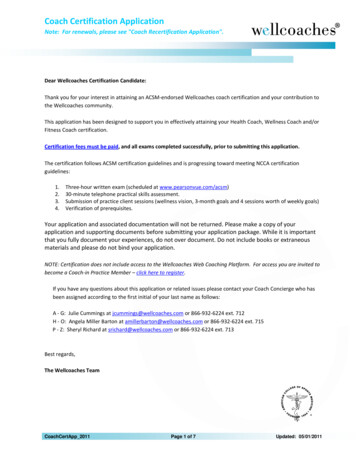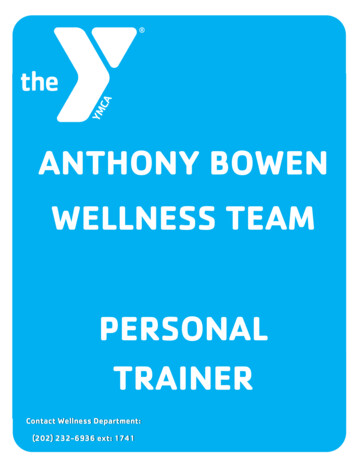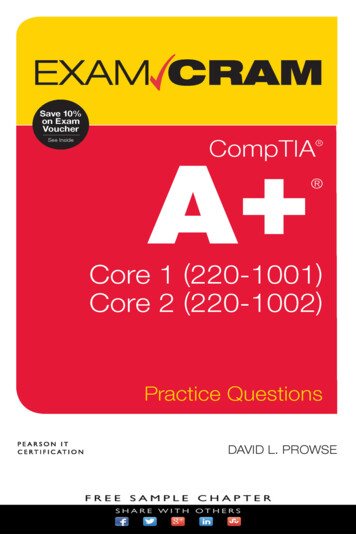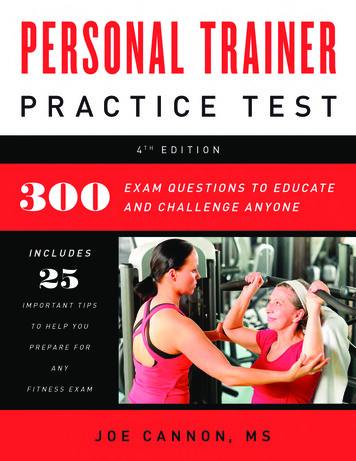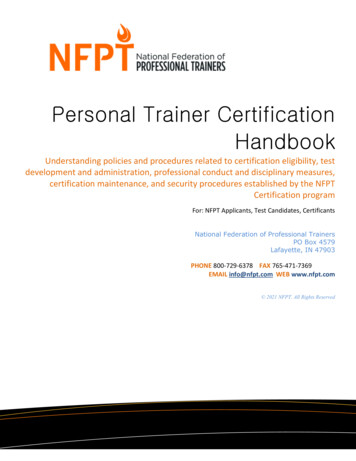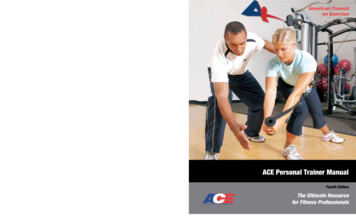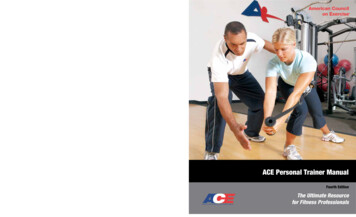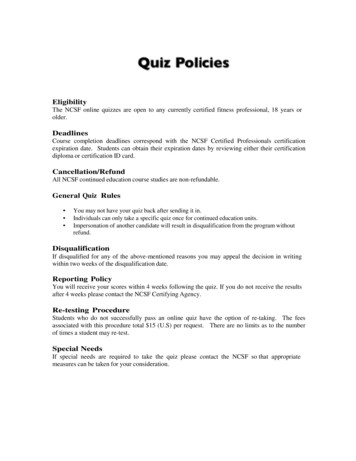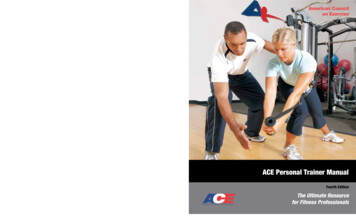
Transcription
Personal Trainer CertificationPractice Exam(Item #: 15)
Thank you for investing in NETA’s Personal Trainer Certification Practice Exam. The purpose of this practiceexam is to test your knowledge and understanding of the subject matter and key concepts that may appear onthe actual certification exam. The practice exam also serves to familiarize you with common multiple-choicequestion formats and to reinforce your self-guided study for the certification exam. The sample questionscontained within this practice exam are NOT actual questions appearing on the certification exam. However,every effort has been taken to ensure that the sample questions contained within this practice exam arerepresentative of the breadth and depth of subject matter to be seen on the actual certification exam.Candidates for NETA’s NCCA-accredited Personal Trainer Certification Exam are encouraged to refer to thePersonal Trainer Study Guide, located on NETA’s website (www.netafit.org) for a comprehensive overview ofthe subject matter to be studied in preparation for the certification exam.The most common type of question found on certification examinations is the multiple-choice question. Allmultiple-choice questions consist of two basic parts: the stem and the response options. The stem is theintroductory statement or question that allows the candidate to understand what is being asked or assessed,and elicits the correct response. The stem may be written as a direct question, an incomplete statement, or ina best-answer format. The responses are suggested options that answer the question or complete thestatement presented in the stem, only one of which is the correct answer (known as the key) and theremaining three are incorrect responses (known as distractors).There are generally three types of multiple-choice questions that appear on certification exams: recall,application, and analysis. These types of questions may be arranged on a continuum such that recall questionsare the most basic, application questions require more thought, and analysis questions involve the highestlevel of cognitive processing and problem solving. A recall question requires that you simply remember facts,definitions, rules, guidelines, etc. Application questions require that you apply knowledge to a certainsituation. Analysis questions require you to take more than one piece of information into consideration andrecognize the relationship between the information and/or variables presented in order to identify a problemand an appropriate solution.Personal Trainer Practice Exam (Rev 6: 9/16)1 2016 NETA
NETA’s actual Personal Trainer Certification Exam consists of 120 multiple-choice questions using fourresponse options (A-D), of which 100 questions are scored and 20 questions are experimental (i.e., ‘pre-test’).The experimental questions are undergoing a pre-testing process to evaluate performance and validity of eachitem before introduction on future exams as scored questions. The experimental questions are randomlyplaced throughout the exam so candidates are blinded as to which are among the 100 scored and the 20experimental questions. Candidate responses to experimental questions do NOT affect the score or pass/failstatus of their exam. Candidates are permitted up to 120 minutes to complete the exam. Please refer to theExam Candidate Handbook located on NETA’s website for important information, policies, and proceduresregarding NETA’s NCCA-accredited Personal Trainer Certification Exam.Please remember that the following practice exam is intended to be one of many tools utilized by candidatespreparing for NETA’s Personal Trainer Certification Exam. Successful performance on this practice exam doesnot guarantee a positive outcome on the actual certification exam. Candidates are again encouraged to reviewthe Personal Trainer Study Guide for a comprehensive list of content areas to be studied and therecommended resources to support your preparation for the certification exam. To successfully prepare forthe certification exam, NETA recommends that candidates devote an appropriate amount of time (e.g., atleast 30-45 days) and effort to self-directed study prior to attempting the actual certification exam.If you have questions regarding preparation for NETA’s Personal Trainer Certification Exam, please contactNETA’s Education Department at 1-800-237-6242.NETA’s Personal Trainer Practice Exam is copyrighted information and may not be reproduced or disseminatedwithout the express written permission of the National Exercise Trainers Association.Personal Trainer Practice Exam (Rev 6: 9/16)2 2016 NETA
Personal Trainer Practice Exam1. Which of the following statements represents an outcome-oriented goal?A. I will complete a minimum of 2 resistance training sessions each week.B. I will reduce my body weight by 15 pounds over the next 3 months.C. I will perform 250 minutes of moderate-intensity cardiorespiratory exercise each week.D. I will decrease my caloric intake by 300 calories per day.2. What is the primary muscle involved in horizontal adduction of the humerus?A. RhomboidsB. Posterior DeltoidC. Pectoralis MajorD. Gastrocnemius3. When performing standing hip abduction using a cable column, which of the followingmodifications will decrease the torque applied to the hip joint?A. Selecting a heavier weight on the cable columnB. Positioning the ankle strap closer to the ankleC. Stepping further away from the cable columnD. Raising the ankle strap closer to the knee4. An energy bar contains 3 grams of fat, 32 grams of carbohydrates, and 12 grams of protein. Whatpercent of the total calories are derived from carbohydrates?A. 13.3%B. 23.6%C. 45.5%D. 63.1%5. The results of a Rockport One-Mile Walk Test indicate that a client’s estimated maximal oxygenconsumption (VO2max) is 37.6 mL/kg/min. Based on this information, what is the client’sestimated maximal capacity expressed in METs?A. 7.6 METsB. 10.7 METsC. 12.4 METsD. 15.1 METs6. Which of the following methods is most appropriate to monitor the exercise intensity for a clientwith hypertension who takes a beta-blockers prescribed by a health care provider?A. Rating of perceived exertion using the category-ratio scaleB. Target heart rate established as a percent of age-predicted maximal heart rateC. Target heart rate established as a percent of heart rate reserveD. Heart rate monitor pre-programmed with the client’s target heart ratePersonal Trainer Practice Exam (Rev 6: 9/16)3 2016 NETA
7. A 50-year-old male client has a resting blood pressure of 136/98 mmHg, a total cholesterol levelof 260 mg/dL, and a HDL level of 55 mg/dL. He has been sedentary for the last 10 years and hasnot used tobacco products since his mid-twenties. Based on the information provided, how manymajor, controllable risk factors for cardiovascular disease (CVD) does this client have?A. TwoB. ThreeC. FourD. Five8. Prior to a personal training session, a client indicates that she has been experiencing some leftknee soreness that persists for several days after running on the treadmill. In which section of aprogress note is this information to be documented?A. SubjectiveB. ObjectiveC. AssessmentD. Plan9. A new member of the health club has signed up for a fitness orientation to learn how to use theexercise equipment. The individual indicates that he does not currently perform any regularphysical activity. Based on the information provided, in which stage of the transtheoretical modelis this individual with regard to the adoption of a physically active lifestyle?A. PrecontemplationB. ContemplationC. PreparationD. Action10. A male client currently weighs 237 lbs (107.5 kg). Based on skinfold testing, his estimated bodycomposition is currently 24% body fat. What is his goal body weight to reduce his bodycomposition to 20% body fat?A. 181 lbs (82.1 kg)B. 204 lbs (92.5 kg)C. 216 lbs (98.0 kg)D. 225 lbs (102.1 kg)11. Which of the following is a common liability exposure for personal trainers?A. Failure to conduct appropriate preparticipation screening procedures prior to initiating anexercise program with a new client.B. Referring a client with symptomatic cardiovascular disease to an appropriate health careprovider.C. Educating a client with regard to healthy dietary habits in accordance with the DietaryGuidelines for Americans.D. Purchasing an insufficient amount of professional liability insurance coverage.Personal Trainer Practice Exam (Rev 6: 9/16)4 2016 NETA
12. Which of the following key processes of motivational interviewing is addressed first to helpprospective client overcome ambivalence to regular physical activity?A. PlanningB. FocusingC. EngagingD. Evoking13. As a personal trainer employed at a local fitness center, which of the following is a violation ofNETA’s Professional Code of Ethics?A. Declining personal training services to a member of the facility who has medical needsbeyond the scope of the personal trainer’s education and experienceB. Attempting to engage a personal training client into an intimate relationship outside of thefitness facilityC. Promoting personal training services by posting a flyer and displaying business cards in thefitness center and throughout the facilityD. Cancelling a session with a client because the personal trainer accidentally double-bookedtheir schedule14. Which of the following best describes the Physical Activity Readiness Questionnaire (PAR-Q)? ThePAR-Q is aA. document used to explain the potential risks and discomforts associated with exercise.B. document completed by a health care provider indicating medical clearance to participatein an exercise program.C. questionnaire used to identify an individual’s current stage of behavioral change.D. screening tool used to identify those who should consult with a health care provider priorto participation in an exercise program.15. Which of the following statements is an example of an amplified reflection?A. “So on the one hand you enjoy eating snack foods, but you have also mentioned that youfeel much better when you eat more fruits and vegetables.”B. “It sounds like it would be absolutely impossible to make time for an exercise program inyour busy schedule.”C. “So you are feeling overwhelmed by all of your commitments and frustrated that exercisehas not fit into your schedule.”D. “I hear you saying that you don’t have time to prepare healthy meals due to your busyschedule of work and then getting your kids to their after-school activities.”16. Which of the following is recommended during the concentric phase of a resistance trainingexercise for a participant performing 8 to 10 repetitions per set? The participant shouldA. inhale.B. hold their breath.C. exhale.D. perform the Valsalva maneuver.Personal Trainer Practice Exam (Rev 6: 9/16)5 2016 NETA
17. At what cadence is the metronome set when performing the YMCA 3-Minute Step Test?A. 54 beats per minuteB. 60 beats per minuteC. 88 beats per minuteD. 96 beats per minute18. Which of the following strategies is likely to be most effective to establish rapport withprospective clients?A. Great fitness center members with a genuine smile and remember each member’s nameB. Approach members in the fitness center and point out the errors in their exercisetechniqueC. Allow members to complete their workouts independently without being interruptedD. Inform members of your qualifications, knowledge, and experience as a personal trainer19. According to the Dietary Guidelines for Americans, adults shouldA. completely abstain from all added sugars.B. consume no more than 2,300 of sodium daily.C. shift from foods containing unsaturated fats to protein-based foods with saturated fats.D. Strive to consume at least 400 mg of dietary cholesterol per day.20. A 35-year-old male client has a resting heart rate of 68. Calculate the target heart rate rangecorresponding to 50% to 70% of his heart rate reserve.A. 110 to 135 bpmB. 118 to 142 bpmC. 127 to 150 bpmD. 135 to 158 bpm21. When measuring resting blood pressure, the last audible Korotkoff sound represents theA. rate pressure product.B. diastolic pressure.C. oxygen deficit.D. systolic pressure.22. Which of the following strategies may be effective to increase a client’s self-efficacy with regardto the adoption of regular physical activity?A. Share the testimonials of other clients who have experienced positive outcomes as theresult of their exercise programs.B. Establish challenging goals focused on long-term outcomes of regular exercise.C. Lead the client through a difficult interval training program to increase their tolerance ofexercise.D. Inform the client about your education, credentials, and experience as a exerciseprofessional.Personal Trainer Practice Exam (Rev 6: 9/16)6 2016 NETA
23. Which of the following resistance training exercises is contraindicated for a client who has beenrecently diagnosed by a health care provider as having shoulder impingement syndrome?A. Seated narrow row machineB. Lat pulldown on a cable-based machineC. Shoulder extension using resistance tubingD. Side-lying shoulder external rotation using a dumbbell24. According to the Physical Activity Guidelines for Americans (2008), for substantial health benefits,adults should performA. muscle-strengthening activities 4 or more days per week.B. 75 minutes of vigorous-intensity aerobic physical activity on a daily basis.C. no more than 200 minutes of moderate-intensity physical activity per week.D. at least 150 minutes of moderate-intensity aerobic physical activity each week.25. During the concentric phase of a barbell bench press, which of the following joint actions occur?A. Elbow flexion and shoulder abductionB. Scapular retraction and shoulder flexionC. Arm horizontal adduction and elbow extensionD. Shoulder extension and arm horizontal abduction26. What is the correct anatomic location at which to obtain the thigh skinfold measurement?A. Diagonal fold, in line with the natural angle of the iliac crest taken in the anterior axillaryline immediately superior to the iliac crestB. Vertical fold, on the anterior aspect of the femur, midway between the proximal border ofthe patella and the inguinal creaseC. Horizontal fold, on the posterior aspect of the humerus, halfway between the acromionand olecranon processesD. Vertical fold, 1-2 cm below the inferior angle of the scapula27. For which of the following scenarios is referral to a health care provider recommended to obtainmedical clearance?A. A sedentary individual planning to engage in moderate-intensity exercise, who isasymptomatic without known cardiovascular, metabolic, or renal diseaseB. A physically-active individual planning to continue moderate-intensity exercise, who isasymptomatic with known cardiovascular diseaseC. A sedentary individual planning to begin a light- to moderate-intensity exercise program,who is asymptomatic with known cardiovascular diseaseD. A physically-active individual planning to progress to vigorous-intensity exercise, who isasymptomatic without known cardiovascular, metabolic, or renal diseasePersonal Trainer Practice Exam (Rev 6: 9/16)7 2016 NETA
28. According to the National Weight Control Registry, which of the following behaviors ischaracteristic of individuals who have successfully maintained weight loss?A. Consuming a very low calorie diet of less than 1,000 calories per dayB. Monitoring body weight both in the morning and evening every day of the weekC. Working with a certified personal trainer at least 2 times per weekD. Performing regular moderate-intensity physical activity equivalent to approximately 300minutes per week29. Which of the following is an expected adaptation to a regular cardiorespiratory exercise program?A. Decreased resting heart rateB. Increased number of type IIb muscle fibersC. Increased resting diastolic blood pressureD. Decreased mitochondrial density of type I muscle fibers30. According to the American College of Sports Medicine (ACSM), how many repetitions per set arerecommended to improve strength and power in most adults?A. 2 - 3B. 5 - 7C. 8 - 12D. 15 - 2031. Which of the following open-ended questions is most likely to elicit statements in favor ofadopting regular physical activity (i.e., ‘change talk’) from a client?A. When you have exercised in the past, what positive changes have you noticed with regardto both your body and your mood?B. Do you feel that regular physical activity is important for your overall health?C. What have been some of the obstacles or barriers that have prevented you from beingphysically active in the past?D. Why don’t you just set some time aside for exercise on your schedule every day?32. Which of the following exercises is most appropriate for a client having muscle imbalancescharacteristic of upper cross syndrome?A. Chest press machineB. Seated narrow rowC. Shoulder internal rotation using a cable columnD. Dumbbell shoulder shrug33. A client is walking on a treadmill at 3.2 mph and 5% grade, which corresponds to a relative oxygenconsumption of 19.8 mL/kg/min. Exercise at this absolute intensity level is classified asA. light.B. moderate.C. vigorous.D. very vigorous.Personal Trainer Practice Exam (Rev 6: 9/16)8 2016 NETA
34. A client is asked, “On a scale of 0 to 10, with 10 representing the highest level of confidence, howconfident are you in your ability to consume at least 3 servings of vegetables daily?” The clientresponds, “6.” Which follow-up question is most likely to be counter-productive by eliciting aresponse in favor of maintaining their current diet low in vegetable consumption (i.e., sustaintalk)?A. “What causes you to rate your confidence as a 6 versus a 4 or 5?”B. “That is good, what makes you select 6 instead of a very low number like 2 or 3?C. “Is see, why do you say 6 instead of an 8 or 9?D. “A 6 is pretty good, what vegetables to you like the most?”35. A 47-year-old female client is planning to complete her first 5K (3.1 mile) race. During an initialfitness assessment, she completed the Rockport One-Mile Walk Test in 19 minutes and 39seconds (19:39). After 12 weeks of training, she is now able to walk a mile in 15 minutes. Whichof the following protocols may be most appropriate to reassess the client’s improvedcardiorespiratory fitness?A. YMCA 3-Minute Step TestB. Cooper 1.5 Mile Run TestC. YMCA Cycle Ergometer TestD. 12-Minute Walk/Run Test36. A 39-year-old male client is beginning an exercise program. Based on his current level ofcardiorespiratory fitness, it is determined that a moderate-intensity corresponding to 70% of hisage-predicted maximum heart rate is appropriate for his steady state aerobic exercise. What is histarget heart rate at this specific intensity?A. 127 bpmB. 143 bpmC. 154 bpmD. 181 bpm37. According to early researchers, what percent of the communicated message is attributed tononverbal communication such as body language, facial expressions, and gestures?A. 7%B. 24%C. 38%D. 55%38. Based on the acceptable macronutrient distribution range (AMDR), what is the maximum amountof fat intake per day for an adult using the U.S.-Style Health Eating Pattern at the 2,000-calorielevel?A. 35 grams of fat per dayB. 56 grams of fat per dayC. 78 grams of fat per dayD. 90 grams of fat per dayPersonal Trainer Practice Exam (Rev 6: 9/16)9 2016 NETA
39. Which of the following best describes an Informed Consent?A. A preparticipation screening tool used to identify individuals in need of referral to a healthcare provider.B. A document explaining the inherent risks and dangers associated with exercise testingand/or training.C. A form completed by a health care provider allowing an individual to participate in anexercise program.D. A form completed by a parent or legal guardian giving a minor (e.g., youth or adolescent)permission to participate in an exercise program.40. Which of the following suggests a high risk for the development of cardiovascular disease (CVD)?A. A female with a waist circumference of 28 inches and a hip circumference of 34 inchesB. A male with a waist circumference of 34 inches and a hip circumference of 36 inchesC. A male with a waist circumference of 40 inches and a hip circumference of 37 inchesD. A female with a waist circumference of 32 inches and a hip circumference of 35 inches41. According to the American College of Sports Medicine (ACSM), what is the recommendedreasonable target with regard to total stretching time (i.e., volume) for each flexibility exercise?A. 15 secondsB. 30 secondsC. 45 secondsD. 60 seconds42. Which of the following active listening skills may consist of a word or short phase intended tokeep an individual talking without significant interruption or influence from the listener?A. ParaphrasingB. Minimal encouragersC. SummarizingD. Reflections43. An interval training workout is designed so the client will run one lap around an Olympic-size track(400 meters) at an intensity corresponding to 95% of VO2max, followed by 45 seconds of walkingfor active recovery. The work and recovery cycle is completed six times. What is the primaryenergy system utilized during the work intervals of each cycle?A. Phosphagen System (ATP-CP)B. Fatty Acid OxidationC. Anaerobic GlycolysisD. Aerobic GlycolysisPersonal Trainer Practice Exam (Rev 6: 9/16)10 2016 NETA
44. Which of the following is outside of the scope of practice for a personal trainer?A. Massaging a client’s sore gastrocnemius muscle following a difficult high-intensity intervaltraining workoutB. Measuring a client’s resting blood pressure using an aneroid sphygmomanometer and astethoscopeC. Completing a health risk appraisal with a prospective client to determine the need formedical clearanceD. Using coaching techniques such as motivational interviewing to help a client move towarda healthy change in lifestyle.45. To elicit improvements in muscular endurance, a client performs each set of resistance trainingexercises for the major muscle groups to a target range of 15-18 repetitions using 60% of 1-RM.What principle of training does this program design strategy represent?A. Principle of variationB. All-or-none principleC. Principle of specificityD. Principle of progression46. Which of the following fitness assessment protocols provides the best measurement of a client’smuscular strength?A. Push-up TestB. YMCA Bench Press Endurance TestC. Body Weight Squat Screen (i.e., Overhead Squat Assessment)D. One-Repetition Maximum Squat Test47. Which of the following resistance training exercises is performed primarily in the sagittal plane ofmotion?A. Chest press machineB. Leg extension machineC. Dumbbell shoulder pressD. Standing hip abduction using a cable column48. A resistance training exercise that involves a concentric and eccentric phase of action performedagainst a fixed external load is known asA. isotonic.B. isocaloric.C. isometric.D. isokinetic.Personal Trainer Practice Exam (Rev 6: 9/16)11 2016 NETA
49. Which of the following exercises is contraindicated for a post-menopausal woman who has beendiagnosed with osteoporosis?A. Walking on a treadmill at an absolute intensity of 4.0 METsB. Step-ups using a 6-inch stepC. Seated Russian twist with a 8 lb medicine ballD. Aqua-jogging in a pool50. Which of the following acronyms facilitates the recognition of a cerebrovascular event (i.e.,stroke)?A. PRICEB. DOMSC. CPRD. FASTPersonal Trainer Practice Exam (Rev 6: 9/16)12 2016 NETA
Personal TrainerPractice Exam Answer al Trainer Practice Exam (Rev 6: ACDBACD 2016 NETA
Personal Trainer Practice Exam (Rev 6: 9/16) 2 2016 NETA NETA's actual Personal Trainer Certification Exam consists of 120 multiple-choice questions using four response options (A-D), of which 100 questions are scored and 20 questions are experimental (i.e., 'pre-test').
